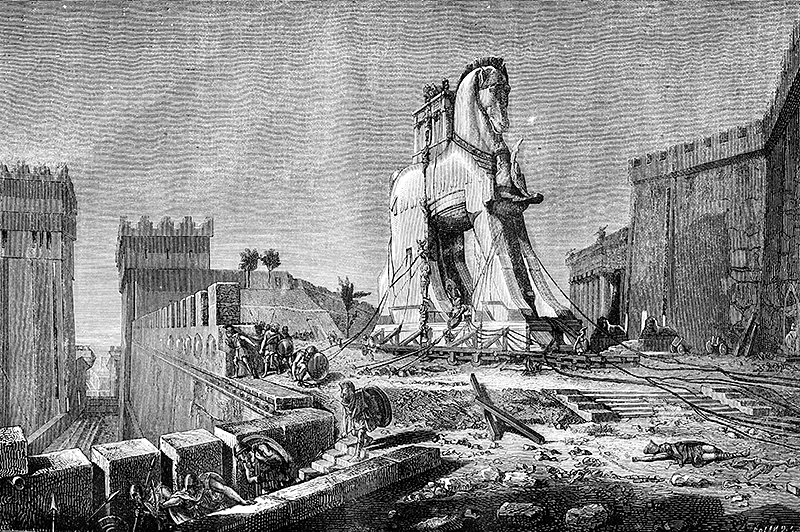Trojan horse, in mythology, was a device that the ancient Greeks used to win their war against the city of Troy. According to myth, the Greek army laid siege to Troy for 10 years. However, the Greeks could not breach (break through) the walls of Troy by force. The Greek hero Odysseus—Ulysses in Latin—developed a plan to take Troy by stealth and cunning. He ordered the Greeks to build a gigantic wooden horse to leave as a gift for the city’s residents, the Trojans. This giant statue was actually hollow, with Greek soldiers hiding inside. One night, the Greeks withdrew their ships from the coastline of Troy, leaving behind only the horse. They pretended to have abandoned the war but hid their ships at a nearby island.

The Trojans discovered the horse outside the city gates accompanied by a man named Sinon. Sinon was left behind by the Greeks to trick the Trojans into bringing the horse inside the city walls. Sinon told the Trojans that the goddess Athena was angry with the Greeks. The Greeks were afraid and decided to leave Troy, first building the horse as an offering to the goddess. Sinon claimed Troy would defeat the Greeks if the Trojans were to bring the statue inside the city walls.
Sinon’s story convinced most of the Trojans. However, a Trojan priest named Laocoön objected to bringing the horse inside the city walls. Laocoön reminded the Trojans that the Greeks were famous for treachery. He warned that the horse could be a trap and that they should destroy it. “I fear the Greeks even when they are bearing gifts,” he said. The prophet Cassandra also warned the Trojans against taking the horse into their city. But the Trojans paid her no attention.
The Trojans pulled the wooden horse through the city gates. That night, they fell asleep after celebrating their apparent victory. Greek soldiers crept out of the horse and opened the city gates. The Greek army rushed in, killing almost all the Trojans and burning Troy.
The story of the Trojan horse served as one of the most popular myths of ancient Greece. It was a common and popular theme in ancient Greek art. The story shows how cunning and intelligence can triumph over brute force. The story remains popular today.
The earliest written sources to tell the complete story of the Trojan horse have been lost. The Trojan War is largely known from two great epic poems—the Iliad and the Odyssey, traditionally attributed to the Greek poet Homer and probably written down sometime after 700 B.C. The Trojan horse is not mentioned in the Iliad, which does not describe the war’s end. The Trojan horse is mentioned only briefly in the Odyssey, which describes the long journey home of Odysseus. The fullest surviving version of the Trojan horse myth is found in the epic poem the Aeneid, written between 30 and 19 B.C. by the Roman poet Virgil.
The term Trojan horse has become an expression for any attempt to trick an opponent into unwittingly accepting something harmful by disguising it as something good. In computing, for example, a Trojan horse is a program that appears useful but has an alternate, generally harmful purpose. It may be used to steal passwords or to deliver a virus.
